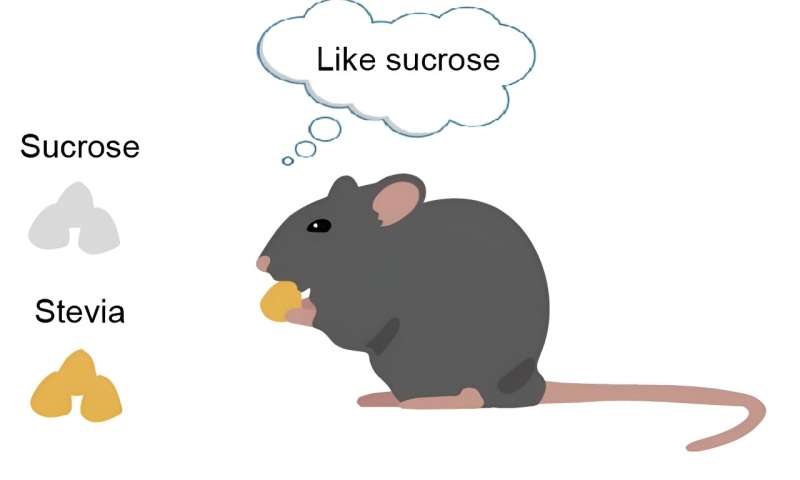April 29, 2024 feature
This article has been reviewed according to Science X's editorial process and policies. Editors have highlighted the following attributes while ensuring the content's credibility:
fact-checked
peer-reviewed publication
trusted source
proofread
Study suggests that stevia is the most brain-compatible sugar substitute

Given the known risks of consuming high amounts of sugar, today many people are looking for alternative sweeteners that produce a similar taste without prompting significant weight gain and causing other health issues. While research suggests that the brain can tell the difference between different sweet substances, the neural processes underlying this ability to tell sweeteners apart remain poorly understood.
Researchers at University of Shanghai for Science and Technology, the Chinese Academy of Sciences (CAS), and other institutes in China recently carried out a study aimed at better understanding what happens in the brain of mice when they are fed different types of sweeteners. Their findings, published in Neuroscience Research, suggest that the response of neurons to sucrose and stevia is similar, suggesting that stevia could be an equally pleasant but healthier sugar substitute.
"Obesity is a significant issue worldwide, and the use of sweeteners as a substitute for sucrose is a current trend in the food industry," Yingjie Zhu, co-author of the paper, told Medical Xpress. "Although they all possess sweetness, many sugar substitutes have noticeable differences compared to sucrose when consumed. Therefore, our initial idea was to investigate whether there would be a specific brain region in the central nervous system that could reflect the differences between these sugar substitutes and sucrose in real-time."
Stevia is a widely used sweetener derived from leaves of a plant native to South America. Many dieticians recommend stevia as a sugar substitute, as it is very sweet but has fewer calories and minimal effects on blood glucose levels. The key objective of the recent work by Zhu and his colleagues was to investigate how the brain of mice responded after they had consumed stevia, sugar, or one of three other sweeteners (i.e., xylitol, glycyrrhizin, and mogroside).
The team hoped to unveil how neurons in the mouse brain responded to the consistent consumption of these different sweeteners over a six-week period. In addition, they were interested in determining whether any of the low-calorie sweeteners they examined elicited similar brain responses to sugar.
"Our previous research identified that the activity of neurons in the paraventricular nucleus of the thalamus (PVT) can track stimulus salience," Zhu explained. "Therefore, as part of our new study, we recorded the activity intensity in the PVT of mice while they consumed various sweeteners and sucrose."
The researchers fed mice six different diets for a period of six weeks. One group of mice was fed a so-called control diet (with a mixture of sweeteners), while the other groups were fed a diet with high amounts of sugar, stevia, xylitol, glycyrrhizin, or mogroside, respectively.
Zhu and his colleagues recorded the activity of neurons in the brain of the mice in real-time, using in vivo fluorescence calcium imaging. This an experimental technique that allows scientists to monitor changes in calcium levels within cells, which in turn unveils these cells' activity patterns.
Interestingly, the team's recordings revealed that compared to other sugar substitutes considered as part of this study, stevia induced activity in the PVT that more closely resembled that elicited by sugar intake. This suggests that stevia is the most "brain compatible" among most widely used sugar alternatives, most closely mirroring the perceived taste of sugar.
"We found that, given an abundance of food supply, compared to other sugar substitutes, the activity in the PVT brain region induced by stevia was most similar to that induced by sucrose," Zhu said. "This suggests that stevia could potentially be the most brain-compatible sugar substitute. Therefore, in the relevant food and beverage industries, stevia should receive more attention."
In the future, this recent study could encourage more food & drink producers to incorporate stevia in their products to reduce their calorie count. In addition, it could inspire other neuroscientists to further examine the neural underpinnings of stevia consumption.
"We were delighted to observe a high similarity in brain activity in mice when consuming stevia and sucrose," Zhu added. "Consequently, we hope to investigate whether a similar phenomenon exists in the human brain using fMRI in future studies."
More information: Shaolei Jiang et al, Neuronal activity in the anterior paraventricular nucleus of thalamus positively correlated with sweetener consumption in mice, Neuroscience Research (2024). DOI: 10.1016/j.neures.2024.02.002
© 2024 Science X Network




















